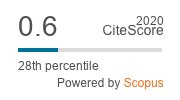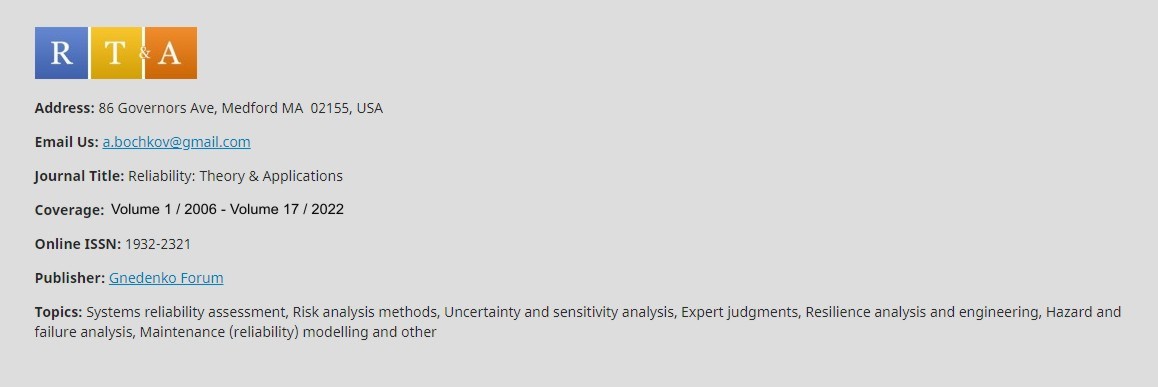|
About Us | Submission | Editorial Team | Privacy Statement | Current Issue | Templates & Author Guidelines | Archives | Contacts
|
||
|
|
V. S. Kharchenko, M. A. Yastrebenetsky About Conception of Big Safety
Concept of Big Safety (BS) is discussed. BS is a result of crossing of the following 10Big: Big property (nuclear safety, radiation safety, functional safety, information (cyber) security, fire safety ,physical safety, infection safety, safety from natural hazards, etc.); Big/complex environment (a lot of factors of influence and parameters); Big/complex system; Big value of a fatal failure or event; Big number of causes of failure; Big data which should be processed; Big number of requirements to safety; Big time and process complexity of development of systems; Big toolbox for safety assessment and assurance; Big resources for assurance and recovery. General principles and methods for assessing and assurance of Big Safety are described considering experience of different critical domains, first of all, NPPs. Some well-known accidents in context of Black Swan theory are analyzed. The strategies of Black Swan tolerance are proposed.
DOI: https://doi.org/10.24412/
Nafisatu Muhammad Usman, Ibrahim Yusuf Introducing Probabilistic Models for Cost Analysis of Sachet Water Plant
The paper deals with modeling and performance assessment of a series-parallel with independent failures using the Markov Birth-Death method and the probabilistic approach. The system consists of five subsystems arranged in series and parallel configurations with three possible states of operation, reduced capacity and failure. First-order systems of ordinary differential equations are developed and recursively resolved using a probabilistic approach via the transition diagram. The state probabilities for the proposed scheme are derived. Using state probabilities, system availability expressions, busy repairman probabilities due to minor and major failures as well as benefit feature are calculated. Profit and availability matrices for each subsystem have been computed to provide various output values for different combinations of parameters. The finding of this paper will boost the efficiency of the system and will be useful for timely maintenance progress, decision-making, preparation and optimization.
DOI: https://doi.org/10.24412/
Eesha Mishra, Santosh Kumar
Blockchain is inalterable and simple confirmable framework that has a noteworthy potential to be an option in contrast to customary races. It carries savvy answers for focal power issue as far as squares having all information in blockchain. In past decades customary races neither fulfill the residents nor government official. The democratic isn't completely made sure about, compromises security and straightforwardness of voters alongside having an excess of time to check the vote. In this paper, we proposed a model that giving the arrangement utilizing the blockchain to dispense with all drawbacks of customary decisions. The security of information, votes and voter is guaranteed in the framework. The sitting tight an ideal opportunity for result diminished fundamentally through the proposed model.
DOI: https://doi.org/10.24412/
Aditya Tiwary, Swati Tiwary
Evaluation of reliability is most important when we have to check the availability of supply in any distribution system. A basic reliability index which is of importance is failure rate of the distribution system. In this paper evaluation of system data i.e. failure rate which is one of the important basic reliability indices of Roy Billinton test system (RBTS) Bus-2 distribution system for educational purpose is done. This paper also evaluates the reliability of each and every feeder section of the RBTS. The mean time to failure (MTTF) of the feeders is also evaluated for each and every feeder section of the distribution system of the RBTS Bus-2 distribution system. The evaluated system data and various reliability indices can be used for educational purpose.
DOI: https://doi.org/10.24412/
Jens Braband, Hendrik Schäbe Analysis of the Risk Model of German Corona Warning App
In Germany an App has been introduced to cope with the Corona epidemic. In this paper we describe, how the app works and analyze the semi-quantitative risk model that has been used in the app, because a large number of semi-quantitative risk models are known that are not consistent. Further we discuss in how far the Corona app in its current state can contribute to mitigate the pandemic. The risk model of the German Corona warning app has several interesting, somewhat puzzling properties. In this paper we describe the analysis and its results related to the underlying risk model.
DOI: https://doi.org/10.24412/
M.D. Katsman, V.K. Myronenko, V.I. Matsiuk, P.V. Lapin
The article discusses some common mathematical models of counterterrorism and acts of unlawful interference with protected objects. The use of methods of queuing theory of Markov and non-Markov types for modeling the counteraction of security personnel by a malicious group with a random number of criminals in a group and different ways of organizing the actions of such personnel is proposed.
DOI: https://doi.org/10.24412/
E.M. Farhadzadeh , A.Z. Muradaliyev , U.K. Ashurova Methodical Bases of Benchmarking Unique Objects of Electric Power Systems
One of the basic problems of electro power systems is absence of the normative documents regulating operation, maintenance service and repair of the capital equipment, which service life exceeds normative value. We shall name them «oldtech» (OT). The essence of the difficulties demanding overcoming is reduced to absence of methodologies a quantitative estimation of operative reliability and safety of OT, with the subsequent benchmarking of OT. Considering the science-intensive, bulkiness and labour input of the decision of this problem indisputable becomes necessity of development of the corresponding automated systems. In present article, some features of an estimation of an integrated indicator and benchmarking unique objects are resulted. To unique objects, which analogues on the set combination of versions of significant attributes are absent concern. For an illustration of recommended methods and algorithms technical and economic parameters of power units with SGI-400 are used.
DOI: https://doi.org/10.24412/
Mohd Arif Khan, Ahteshamul Haq, Aquil Ahmed Multi-objective Model for Daily Diet Planning
In this paper, we present the development of a daily diet model using fuzzy multi-objective goal programming (GP) to satisfy daily nutrient. We have designed the objective function as minimize the cost of diet, Saturated Fat and carbohydrate. This paper consists of ten consumed foodstuffs as the decision variable. The daily diet’s tolerable lower and upper intake level is given for the Protein, Vit. B6, Vit. C and Calcium. This paper aims to present a stepwise solution procedure based on fuzzy GP to obtain the compromise solution of the diet problem. Finally, a numerical example is illustrated to compare the daily diet plan with weighted GP, pre-emptive GP and fuzzy GP.
DOI: https://doi.org/10.24412/
Kamlesh Kumar Shukla Inverse Ishita Distribution: Properties and Applications
In this paper, new lifetime distribution has been proposed which is an inverse of Ishita distribution Shanker and Shukla (2017). Its statistical and mathematical properties including Reneyi entropy and Stress-strength reliability measure have been discussed. Maximum likelihood estimation method has been used to estimate its parameter. Simulation study has also been carried out to check the behavior of maximum likelihood estimator. Finally, proposed distribution has been applied on lifetime datasets and compares its superiority over other inverse lifetime distributions.
DOI: https://doi.org/10.24412/
K. S. Deepthi , V. M. Chacko Identification of Failure Rate Behaviour of Increasing Convex (Concave) Transformations
In this paper, increasing convex (concave) Total Time on Test (TTT) transform of a lifetime random variable is considered. In order to identify the failure rate model of functions of random variables, the TTT of transformed data can be used. Some properties of the transforms are derived. Some examples are given.
DOI: https://doi.org/10.24412/
Neena Krishna P K, Dr S Jayalakshmi
Acceptance Sampling performs a major role in industry for monitoring process and assessing complains for reducing the cost and inspection time. A truncated life test may be conducted to determine the smallest sample size to ensure certain percentile life time of an items. The operating characteristic function values are obtained according to different quality levels and the minimum ratios of the true average life to the specified average life at the specified producer’s risk are derived. Useful tables are provided for the proposed sampling plan.
DOI: https://doi.org/10.24412/
M. L. Soujanya, P. Vijaya Laxmi, E. Sirisha
In this paper we analyzed an inventory model with two-suppliers, finite life times, multiple working vacations and customers who arrive according to process. Perishable and replenishment rates of two-suppliers are exponentially distributed. The server takes exponential working vacations when the queue is empty. Arrival process follows Poisson distribution and the probability for an ordinary customer is and for negative customer is . Limiting distribution of the assumed model is obtained. Numerical results are presented for cost function and various system performance parameters. The impact of two-suppliers on the optimal reorder points will be useful in developing strategies for handling various perishable inventory problems with replenishment rates.
DOI: https://doi.org/10.24412/
Zinovi Krougly Accuracy and Precision Requirements in Probability Models
Numerical Laplace transform and inverse Laplace transform is a challenging task in queueing theory and others probability models. A double transformation approach is used to find stable, accurate, and computationally efficient methods for performing the numerical Laplace and inverse Laplace transform. To validate and improve the inversion solution obtained, direct Laplace transforms are taken of the numerically inverted transforms to compare with the original function. Algorithms provide increasing accuracy as precision level increases. The most promising methods were applied to computational probability models, when there are no closed-form solutions of the Laplace transform inversion. The computational efficiency compared to precision levels is demonstrated for different service models in queuing systems.
DOI: https://doi.org/10.24412/
Yogesh Pal, Santosh Kumar, Madhulika Singh
The revolutionary discovery in forensic investigation in DNA fingerprinting that helps to identify individuals it is an important tool for molecular research that support the human breeding. DNA fingerprinting model played an important role in identifying an individual in millions of people by looking in unique patterns in their DNA. DNA fingerprinting is a technique that simultaneously detects lots of minisatellites in genome to produce a pattern unique to an individual. In this research work, we analyzed DNA fingerprinting based identification and designed a DNA fingerprinting based identification model along with DNA database management system for 360 degree interlinking i.e. all services and progresses will be progressed by DNAFIDs and database.
DOI: https://doi.org/10.24412/
Rakesh Kumar, Bhavneet Singh Soodan, Sapana Sharma Modelling Health Care Queue Management System Facing Patients’ Impatience using Queuing Theory
In this paper, we study a finite capacity single server queuing model with balking and correlated reneging and discuss its application in queues at health care facilities. The reneging considered so far in the queuing literature is a function of system-state. In many practical situations, reneging may depend on factors other than the system-state. For instance, in health care systems the reneging of patients at two consecutive time marks may be correlated in a sense that if a patient reneges at a time mark then there is a probability that a patient may renege at the next time mark due to the factors like improper check-up, sluggish management, unnecessary costly prescription by doctors, etc. The steady-state solution of the model is derived by using matrix-decomposition method. Finally, the transient performance analysis of the model is performed using Runge-Kutta method.
DOI: https://doi.org/10.24412/
Albin Paul, K.K. Jose Harris Generalized Linear Exponential Distribution and Its Applications
In this paper we consider an extension of the linear exponential distribution based on the Harris generalization method, which includes some of the life time distribution as sub models. Along with the four parameter generalization namely Harris generalized linear exponential distribution, we derive some of its properties such as moments, quantiles and moment generating function. A compound form expression of the density function is given. For the given model the R´enyi entropy, mean residual life and the distribution of order statistics is derived. The problem of estimation of parameters is considered and validated with respect to two real data sets.
DOI: https://doi.org/10.24412/
Neelesh Gupta, A. R. Nigwal, U. K. Khedlekar An Imperfect Production System with Rework and Disruption for Delaying items Considering Shortage
In this article, we have developed an imperfect production system under the following four different cases. The first one is imperfect production with rework, and without disruption, second one is imperfect production with rework and disruption, third one is imperfect production with rework, disruption, and without backlogging, fourth one is imperfect production with rework, disruption and backlogging. For these all cases, we have optimized the regular production time, rework production time, backlog time and backlog quantity. In this article we have considered the demand rate, production rate defective item’s production rate and deteriorating rate are all constant. We have also considered the production rate is always grater than the demand rate. The model is illustrated by numerically and analyzed by graphically.
DOI: https://doi.org/10.24412/
K. H. Ibrahim, M. S. Isa, M. I. Abubakar, I. Yusuf, I. Tukur
In relation to types and advantages of computer network topologies, in this research work, availability and cost analysis of complex computer network is considered to focus on a tree topology network that has four subsystems A,B,C and D and all the subsystems are figured in series and parallel configuration, the subsystem A and B served as computer servers together with two units each and are working 1-out-of-2: G/F policy while C and D subsystems both has three units and are working in 2-out-of-3: G/F scheme, A and B attached to subsystems C and D respectively. The system has two types of failure, degraded (partial failure) or complete failed states. The system is analyzed using supplementary variables techniques and Laplace transform. Copula family and general distribution are employed to restore the complete failed and partial failed states respectively. Computed results have been highlighted by the means of tables and graphs.
DOI: https://doi.org/10.24412/
Dhruv Raghav, D.K. Rawal, Ibrahim Yusuf, Rabiu Hamisu Kankarofi, V.V. Singh
The present paper intends to design and development reliability models for the analysis of distributed hardware-software system. For the determination of reliability and system performance, the study analyzed a distributed system consisting of a single host with two heterogeneous software running on the host and two identical servers configured as series-parallel system. Both client (host), software and server’s failure time are to be exponentially distributed while repairs follow two forms of distributions that are general and Gumbel-Hougaard family copula. The system is analyzed using supplementary variable technique with implications of Laplace transforms. The results are presented in tables and graphs. Some important measures of reliability such as availability of system, reliability of the system, MTTF and cost analysis have been discussed. Some particular cases have also been derived and examined to see the practical effect of the model.
DOI: https://doi.org/10.24412/
Naijun Sha A Copula Approach of Reliability Analysis for Hybrid Systems
Copula is a powerful tool to describe dependence among variables and has gained significant attention in many fields of research. In this paper, we study modeling the lifetimes of two fundamental hybrid systems: series-parallel and parallel-series by copula functions to reflect the effect on dependence of working components in the systems. We consider Farlie-Gumbel-Morgenstern (FGM) and Clayton copula functions to represent dependent structures in parallel and series configuration, respectively. A flexible lifetime distribution, the extended exponential distribution, is applied to the components of system. The explicit expressions of the reliability and mean time to failure (MTTF) of both hybrid systems are obtained. For the purpose of illustration, the effect of different degrees on dependence among components is analyzed and presented for various parameter settings in the lifetime distribution.
DOI: https://doi.org/10.24412/
|
Safety Research :
Safety, Risk, Reliability and Quality:
Statistic, Probability and Uncertainty :
|
|
|
|
|
|
|
||







.png)
.png)
